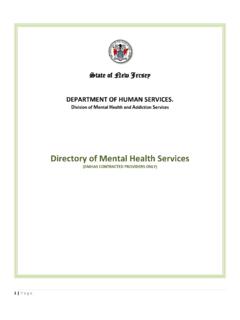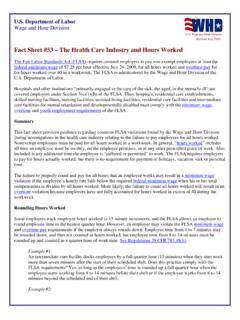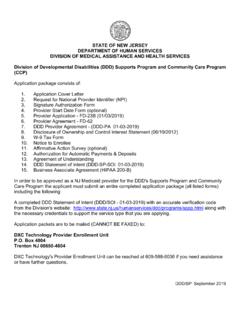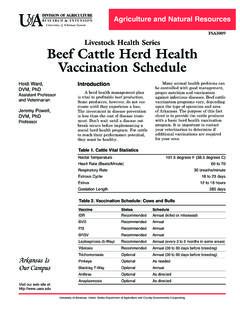Transcription of STEP LOGIC MODELS B
1 BSTEP LOGICMODELS CONTENTS LOGIC MODELS and Program Planning 2 Basic LOGIC model Components 4 Approaches to Developing a LOGIC model 7 Steps for Constructing a LOGIC model 9 The LOGIC model Narrative 15 Workplans: A Note 18 Points to Ponder 19 LOGIC model Supplemental Material 21 LOGIC model Reverse Construction 21 LOGIC model Worksheets 22 LOGIC model Examples Oral Health Infrastructure Global model 32 Oral Health State Plan Development 33 Tobacco Control MODELS 34 Active Play model 36 LOGIC model Bibliography 37 Our thanks to The Office on Smoking and Health and The Division of Physical Activity and Nutrition for allowing us to use their workbooks as guides for the development of this Division of Oral Health workbook 2. Describe the Program 1 BSTEP LOGIC MODELS LOGIC MODELS and Program Planning After you have Defined the Problem ( step 2a Evaluation Guidelines) it is recommended that you construct a program LOGIC model .
2 The LOGIC model depicts program outcomes, how the program is supposed to accomplish these outcomes and what is the basis ( LOGIC ) for these expectations. What LOGIC MODELS can do for you: LOGIC MODELS link program inputs ( , resources) and activities to program products and outcomes ( , goals) while communicating the LOGIC (theory) behind the program, its rationale for existing. LOGIC MODELS can be used to: (1) identify the products, short-term, intermediate, and distal outcomes for your program; (2) link outcomes to each other and to program activities using the identified LOGIC /theory/ model for your program (illustrate cause and effect); (3) incorporate findings from research and demonstration projects; (4) select indicators to measure outcomes depending on the stage of your program s development; (5) illustrate why the program is important as well as its fundamental purpose; (6) depict what intermediate outcomes/products must occur before distal outcomes will be evident; (7) make mid-course adjustments and improvements in your program.
3 And (8) become a common reference point for staff, stakeholders, constituents and funding agency A LOGIC model will assist you in communicating the underlying theory ( LOGIC ) that you have about why your activities are a good solution to the problem identified. LOGIC MODELS can be displayed by varying methods. Some read left to right, others top to bottom with intermittent circles and squares, while still others follow a winding path; all are designed to demonstrate the link ( LOGIC /theory) of what leads to what. What are the links between resources, activities, products and outcomes? Why and how will your program work? 2. Describe the Program 2 LOGIC MODELS often provide the needed synthesis of your program to successfully convey why your program is important as well as the LOGIC behind why you expect it to succeed.
4 A LOGIC model is an iterative tool, providing a framework to revisit throughout program planning, implementation and evaluation. NOTE: Many RFAs now require that you include a LOGIC model of your proposed program. Stakeholders Ideally, the development of a LOGIC model engages stakeholders (identified in step 1 of the Evaluation Guidelines) and guides program development and evaluation planning simultaneously. It provides a forum for stakeholder differences to be identified and considered as well a catalog of resources and support for your program. By including stakeholders, you promote ownership and commitment to the program. It is hoped that all parties can come to an understanding and consensus about program outcomes and limitations, as well as activities to achieve those outcomes and future direction. The LOGIC The LOGIC or rationale for your program can be developed from numerous sources considering context and stage of development of your program.
5 These might include: Focus groups Key informant assessments Community needs assessments Formal behavioral theory Delphi-method or other consensus-based theory Previous evaluation results Evidence-based research/practice/intervention MODELS Faulty LOGIC can lead to ineffective and inefficient programs. The LOGIC is what links resources to activities to products to outcomes. A LOGIC model is your best evidence as to why this program will work and best justification for spending specific resources in a particular direction. In a graphic depiction, the arrows portray the LOGIC . Think of each arrow as a bridge between the boxes. The strength of your bridge depends on the strength of the LOGIC used. Inputs Activities Outcomes 2. Describe the Program 3 LOGIC model COMPONENTS Inputs: Resources that go into the program Activities: Actual events or actions that take place Products: Direct tangible outputs of program activities Outcomes: Impact of the program; the sequence of effects triggered by the program, often expressed in terms of short-term, intermediate, and distal outcomes Arrows: Depict the logical links between inputs, activities and outcomes Inputs are the various resources that go into a program.
6 For an Oral Health Infrastructure Development program, inputs may include: Direct and in-kind funding Staff of Oral Health Unit Partner Organizations (support and resources) Steering or Advisory Board Legislation/Rules/Regulations Equipment Activities are the actual events that take place as part of the program. The following are examples of activities in an Oral Health Infrastructure Development Program: Develop a coalition Write a state oral health plan Develop a comprehensive, integrated surveillance system Develop a culturally appropriate media kit to educate and inform population regarding Oral Health Develop school referral networks Develop fluoridation and sealant programs TIP: List all activities with an action verb to distinguish between activities and products. 2. Describe the Program 4 Outcomes reflect the intended accomplishments of the program.
7 The following are some examples: Increase in oral health legislation/rules/regulations Increase in evidence-based prevention programs Decrease in decay Decrease in untreated decay Increase in oral cancer examinations Increase in awareness of oral cancer causes Decrease in periodontal disease Increase in number of providers using of sealants Products are the direct tangible outputs of program activities. Products and short-term outcomes are often grouped together. Products are distinguished from effects/outcomes in that effects and outcomes make some change in a target audience. The following are some examples of products: Written vision, mission and goal statements for coalition A written State Oral Health Plan A comprehensive Oral Health Surveillance System A completed media campaign kit on oral cancer awareness available for dissemination TIP: List all products with a noun to distinguish between products and activities.
8 Short-term outcomes describe the immediate effects of a program and often focus on the knowledge, attitudes, and skills gained by a target audience. Some examples: Increase in oral health advocacy due to active coalition that represents a broad range of committed stakeholders Increase in evidence-based direction for resources using state plan as the strategic guide Increased public exposure to information regarding oral cancer Intermediate outcomes include behavior change, normative change, and changes in policies. Some examples: Changes in practice law due to coalition activities Mandatory dental screenings for school-aged children implemented based on state plan Increased public behavior towards the prevention of oral cancer 2. Describe the Program 5 Note: Short-term and intermediate outcomes are the direct result of your program.
9 They are the evidence for believing that the distal outcomes will occur given time and credibility of the LOGIC you have used. Distal outcomes often take time to achieve, , decreased morbidity and mortality for health promotion programs. Distal outcomes are the ultimate goals of the program. Some examples: Decrease in prevalence of caries Decrease in prevalence of oral cancer Decrease in prevalence of periodontal disease Decrease in prevalence of disease related to infection control methods NOTE: Products and short-term outcomes often are grouped together for ease of depiction in the LOGIC model framework. DISTAL OUTCOMES Each component is connected to the others by the overarching LOGIC t or theory thus establishing a foundation for evidence-based action the arrows depic thelogic ACTIVITIESPRODUCTS/ SHORT-TERM OUTCOMES INTERMEDIATE OUTCOMES BASIC PROGRAM LOGIC model INPUTS 2.
10 Describe the Program 6 Approaches to Developing a LOGIC model There is no right way to begin a LOGIC model . Design construction is based on stage of the program, identified LOGIC , information available concerning resources, etc. However, you should have a clear definition of the problem before starting construction of your LOGIC model . [Problem definition developed in step 2a of the Evaluation Guidelines] The two approaches described in this Workbook are the Forward LOGIC approach and the Reverse LOGIC approach. We will use the Forward LOGIC approach to demonstrate the construction of the Oral Health Infrastructure LOGIC model . The Reverse LOGIC approach is described in the supplemental section of this workbook. Left to Right or Forward LOGIC ################ Developing your LOGIC model from left to right starts with articulating the program inputs and activities and requires you to work forward towards distal outcomes.














